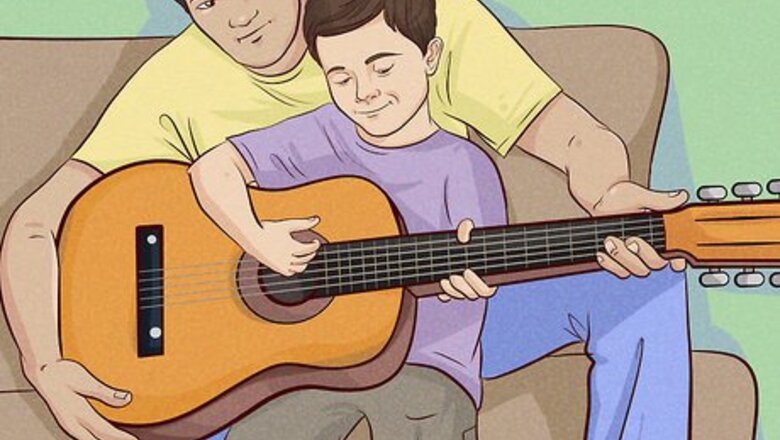
views
X
Research source
Starting with the Basics

Show the child how to hold the guitar correctly. To start, it will probably be easier for the child to learn the guitar sitting rather than standing. Find a sturdy, straight backed chair that is low enough for them to sit with both feet firmly on the floor. It will take some practice for the child to hold their hands and fingers correctly, but emphasizing this at the beginning can keep them from developing repetitive motion injuries later on.

Help the child make friends with their guitar. A guitar can be an intimidating instrument. Encourage the child to play around with the guitar, tapping on the body to hear echoes and plucking strings at random. This kind of unstructured play with the instrument will help the child become familiar with the guitar's sound. Especially if the child is really young (4-6 years old), they may not be ready to start with actual music right away. Just let them play around and experiment, maybe creating their own "songs." Encourage them to pay attention to what they're doing and repeat sounds.
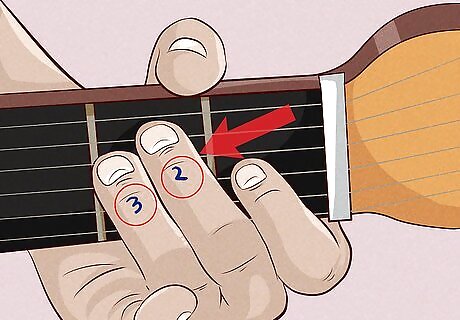
Have patience. A child may not be able to grasp the concepts you want to teach them as quickly as a teenager or adult would. Even some basic knowledge may be unknown to younger children. Remain calm and be prepared to explain even the simplest terms and phrases. For example, if you're teaching a 5-year-old, they may not know which finger is their ring finger and which finger is their index finger. Instead, number the child's fingers. Let them write the numbers on their fingers in washable marker.

Work on single notes and basic scales. Spending a lot of time on scales and theory can cause children to become bored. But you still want to spend some time explaining how the notes are found on the strings and how they relate to each other. Don't spend more than a few minutes on this type of instruction during each lesson, or the kids will get bored and start to dislike the instrument. Most kids have an attention span the same number of minutes as their age – so if you're teaching a 6-year-old, keep this kind of instruction to 6 minutes and then move on to something else.
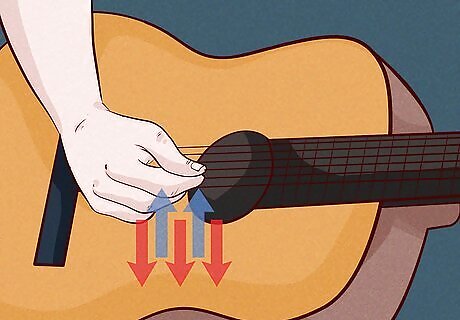
Teach basic strumming patterns. Coordinating the right and left hands can be one of the most difficult things for any beginning guitarist – especially children. A basic down-strum is the easiest pattern to teach, and there are plenty of songs kids can play using this pattern. Once the child can consistently play with a basic down-strum, you can progress to a down-up pattern. If the child is more interested in picking the guitar and playing single-note melodies than playing chords, they still should have a handle on strumming techniques. Demonstrate how a note sounds slightly different on a down-strum than an up-strum.

Simplify chords. Many chords are too difficult for small, uncoordinated fingers to play consistently. Use simplified versions of chords that only require one or two fingers so the child can play them easily. Get yourself a chord guide or download an app to find the simplest chord patterns to teach younger kids. Look for a pattern that only requires one or two fingers. Watch out in particular for chords that require the pinky finger. The pinky is the weakest finger, and a young child's pinky may not be developed enough to press the string cleanly.
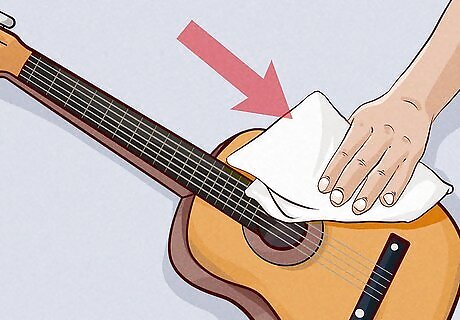
Demonstrate how to correctly put away the guitar. A child will feel more ownership and responsibility for their guitar and their musical education if they know how to properly maintain their instrument. Keep a shammy or soft cloth (such as an old t-shirt) handy, and teach the child to wipe down their guitar after every lesson or practice session. Make sure the child has a quality case and get them in the habit of storing their guitar when they're done playing for the day.
Teaching Fun Songs
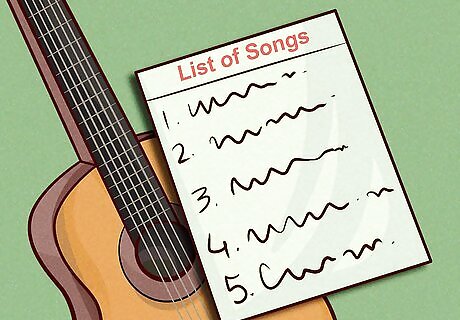
Skip traditional songs. Instead of grinding through traditional songs, such as "Twinkle, Twinkle Little Star," that contemporary kids probably don't care about, go for songs the child is familiar with and already loves. Some songs are great for beginners, but even more complex songs can be broken down into simpler melodies. Ask the child what kind of music they enjoy. Have them list off some of their favorite songs. The more you can include songs the child already enjoys, the easier learning to play will be.
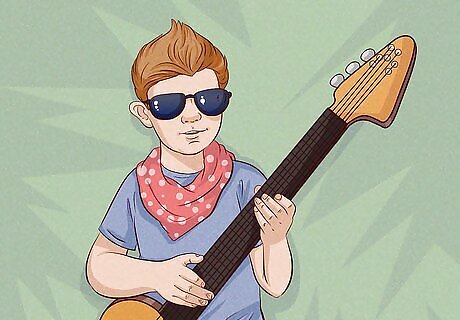
Use simple riffs from classic rock songs. Particularly if the child wants to play electric guitar, classic rock songs are both recognizable and will make the child feel like a rock star even though they only know a few notes. For example, the riff from "Smoke on the Water" is a very simple classic progression that only requires one string. If the child is playing on electric, you can up the distortion so they can really rock with it. Encourage the child to sing along the fret numbers as they play. This will help the child mentally connect the tone with finger placement on the fretboard.
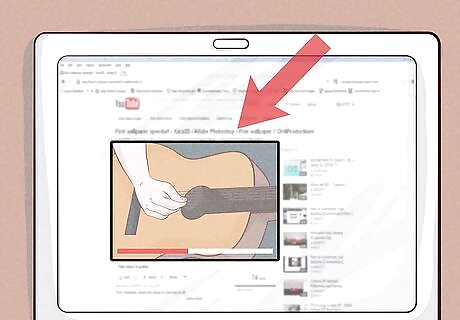
Search for free videos and resources online. While you can spend money on apps or professional teachers, it's not necessary. There are plenty of resources online that you can use to teach kids to play guitar. For example, you can search YouTube for instructional videos. Make sure you watch the video ahead of time so you know it's kid-friendly and of good quality. There are also websites run by professional teachers who have put brief lessons online for free. For example, Coursera has free beginning guitar courses in conjunction with the Berklee College of Music. These classes may be too complex for younger kids. Justin Guitar is another free website where you can find introductory and beginner videos to help kids learn guitar basics, including simple chords and how to tune their guitars.
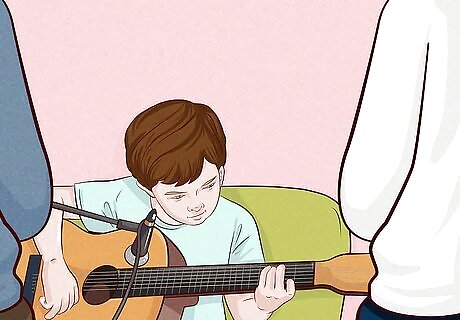
Have home concerts. Once the kids start to play a few riffs, home concerts give them a chance to show off as well as get comfortable playing their instruments in front of a group of people. In warmer months, have concerts in the backyard and invite the neighbors.
Choosing an Instrument
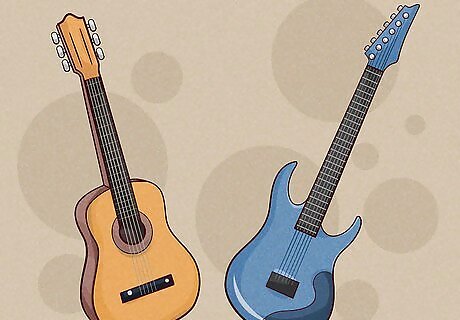
Decide on acoustic or electric. You can find child-sized versions of both acoustic and electric guitars, and beginner's models typically will be roughly the same price. Talk to the child about what kind of music they enjoy and want to play. This can help you choose between acoustic and electric. Generally, if the child enjoys singer-songwriter, folk, and country music, they probably will feel more at home with an acoustic guitar. Kids who are more into rock music typically will want an electric guitar. Electric guitars can be easier to play than acoustic because the action is lower. Since there is less space between the strings and the fretboard, little fingers don't have to work as hard to play. With electric guitars, you also have the option of plugging headphones into the amp for silent practice. This can be helpful if you are concerned about disturbing neighbors or other people in the house.
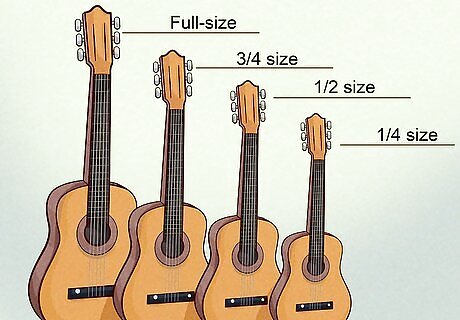
Get the right size for the child's age. If the guitar is too large for the child, playing will be frustrating. Guitars are typically measured by scale. Start with the size recommended for the child's age, but don't be afraid to go up a size if the child has larger hands or is taller than average. Get a 1/4 size guitar if the child is 4-6 years old. Get a 1/2 size guitar if the child is 6-9 years old. Get a 3/4 size guitar if the child is 9-11 years old. A full-size guitar is appropriate for children 12 years old or older.
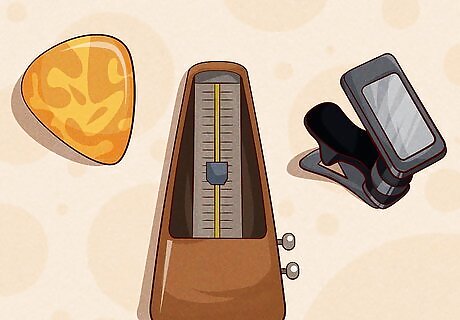
Get necessary accessories. To start playing a guitar, your child will need several picks, a metronome, a tuner, and probably a capo for simplified chords. Get these accessories together and let the child help pick them out. For example, the child can pick out fun picks in cool colors with cartoons or images on them that they like. Having fun accessories will help motivate the child to play. You can download metronome and tuner apps for a tablet or smart phone. If you're going to use these, make sure the child will have unlimited access to the device whenever they want to practice.
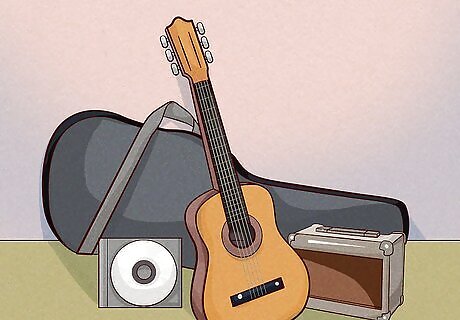
Try a beginner's kit. A number of major guitar manufacturers, such as Gibson and Fender, put out beginner's kits that come with all the necessary accessories you'll need to get the child started playing guitar. Beginner's kits are especially helpful if you're getting an electric guitar, since they come up with an amp and everything else you need. Many of these kits also come with a workbook or DVD that includes a few beginner lessons and some songs.
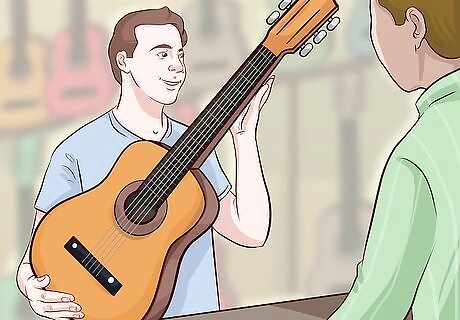
Buy the guitar in person. No amount of research substitutes for holding a guitar in your hands and trying it out for yourself. While you don't need to spend a lot of money, if a child actually wants to learn guitar you need to buy them a quality instrument – not a toy. Take time to examine the guitar, and talk to staff at the guitar shop. Do some research beforehand so you know generally what you're looking for, then go to a retailer that specializes in musical instruments. Avoid buying the child's guitar at a discount store or pawn shop. You may save some money, but you can't guarantee you're getting a quality instrument. You also won't have the benefit of educated and experienced staff to assist you.

















Comments
0 comment